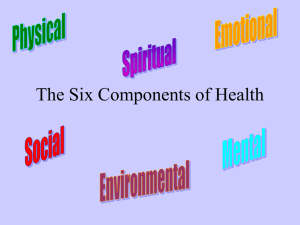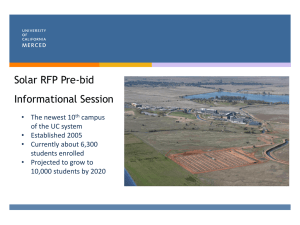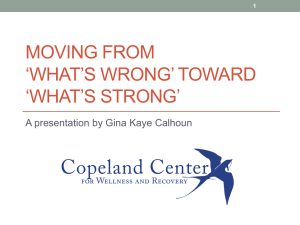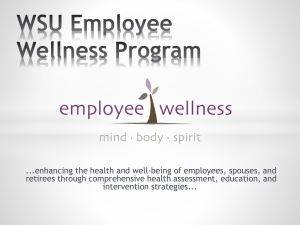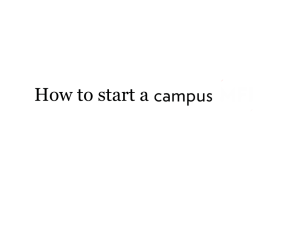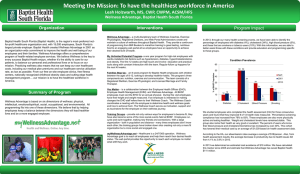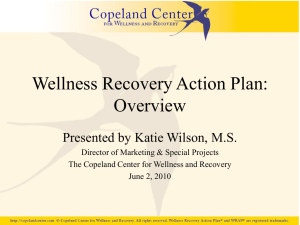Diverse Approaches to Putting Healthy Campus 2020 into Practice
advertisement
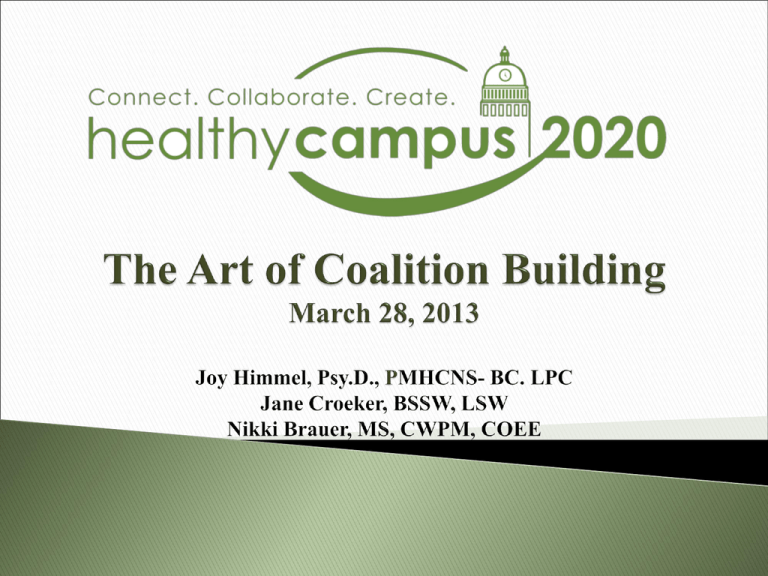
PENN STATE ALTOONA Healthy Campus 2020 Joy Himmel Psy.D,PMH-CNS, LPC Director Health & Wellness Center Health & Wellness Center Four year liberal arts 4,000 students Rural setting On and off campus housing HWC: Integrated Care model; Primary Care, Health Promotion, Counseling and Disability Services Two full-time NP’s Contracted physician Medical Assistant (s) Health Services One contracted psychiatrist Five LPC’s ◦ Two MH counseling ◦ One MH and ATOD ◦ One Triage/Outreach and case management ◦ One alcohol and other drug intervention program Counseling & Psychological Services Alcohol and Drug Abuse Prevention TeamCommunity Coalition (1997-2009) Wellness outreach initiatives – Health & Wellness Center, Residence Life, Student Life ◦ Core Survey ◦ NCHA • Inconsistent and poorly coordinated efforts Difficulty with faculty engagement, participation Primary focus on high risk alcohol use Inconsistency with measurable objectives and outcomes Reporting structure to the Director of Student Affairs A – Assess (what data is collected?) D - Diagnosis (what is the problem?) O - Outcome Identification P – Plan (how to manage the problem) I - Implement (putting plan into action) E - Evaluate (did the plan work?) How To Start: (top down) Vision/Mission: ◦ Address environmental factors that reduce risk ◦ Coordinate campus/community efforts related to student health, wellness, and safety ◦ Promote positive choices and behaviors ◦ Provide a coordinated continuum of care Develop a coalition model; Identify key stakeholders Health Advisory Board Steering Committee Alcohol and Other Drug Prevention Sexual Health, Sexual Assault/Violen ce Prevention Mental Health and Suicide Prevention Reporting structure to the Chancellor Steering Committee: Director Student Affairs, Director Health & Wellness Center, Associate Dean of Academic Affairs ◦ Role: Guidance, Liaison, Oversight, Budget approval Three sub-committee structure composed of stakeholders from campus/community Co-chair model- (1) faculty (1) staff Sub-committee chairs were appointed based on leadership- representing academics and student affairs- Fall 2011 Committee members: representation from faculty, staff, students, community Initial meetings: ◦ Steering Committee meeting- Spring 2012 ◦ Co-chair meeting with Steering Committee- Spring 2012 HAB Composition Faculty representatives: Variety of departments Staff representatives: Student life, Res. Life, Student Conduct Student representatives: Student groups, Greek, Athletes Landlords Local agencies: Counseling, Sexual Assault, D&A PLCB: Pennsylvania Liquor Control Board Police departments: campus and community Hospital High Schools NCHA campus specific and national data (Spring 2013, 2011, 2009) Healthy Minds Study (2010) Healthy People 2020, Healthy Campus 2020 NCDP data PSU Safe data (first year alcohol module) PSU Aware data (first year sexual assault) Counseling Center and Health Center data Development of an annual strategic plan with Goals, baseline data/source, Objectives, Action Steps, Responsible party(s), Evaluation ◦ Annual budget based on targeted need$4,000/sub-committee, plus funds for the NCHA every other year ◦ Data driven and evidenced-based plans linked to the budget Monthly sub-committee meetings Steering Committee involvement throughout the year Annual outcome based reports Begin planning for 2013-2014, based on new NCHA data Stress the importance of measurable objectives (percentage increase/decrease) Do additional root cause analysis to determine other directions for planning and intervention Challenges Active involvement of membership- 15 members per sub-committee (distribution of tasks) Faculty engagement Developing measurable objectives and actions based on identified needs Systemic approach/ evaluation Jane Croeker, LSW Health and Wellness Promotion Director University of North Dakota 15,250 students 11,953 undergrads Grad, Law & Medical Non-Res/Alien 6.6% Hispanic 2.4% ◦ AI/AN 2.15% ◦ Black/Non His 2.1% ◦ White/Non-His 79.1% ◦ ◦ ◦ ◦ Located in Grand Forks – 50,000 people Student Health Services Counseling Center Wellness Center Work Well (Employee Wellness) H&W Promotion Team ◦ Healthy UND/Healthy UND 2020 Building a Solid Foundation Creating a Blueprint for the Future Vision: Healthier Students, Faculty, and Staff October of 2000 Launch Who do we know? Who might benefit? Who has an interest? What perspectives are needed? Reach out and invite Ask for input Who are we missing? What H& W programs/services are already in place? What are our gaps/needs? What advice/ideas do you have? Are you willing to get involved (provided options)? Who else should I talk to? Presidential Kick Off Mission: To work in partnership to promote healthy lifestyle choices by enhancing awareness, building skills, changing social norms, and creating a healthier environment Membership: 202 UND students, administrators, faculty, and staff Quilt of Hope Spirituality Walk Prairie Garden Healthy UND Walking Trails Wellness Center Work Well Healthy Food Options Wellness Living Learning Community Tobacco-free Campus Charge: Create an action plan to address top health and wellness issues that negatively impact students’ academic performance and retention. Students ◦ Student Government, Greek, Undergrad, Grad, Diversity, ◦ Peer Educators Faculty ◦ ◦ ◦ ◦ ◦ Nutrition & Dietetics Physical Education Nursing Medicine Teaching & Learning Campus Minister First Lady Staff Library Director Architect TRIO programs Student Success Center Residence Services/Dining ◦ H&W Unit ◦ ◦ ◦ ◦ ◦ AVP for H&W Fitness Nutrition Mental Health Clinic Nurse Health Promotion Academic success Not the usual suspects Group norms Socio-ecological framework Vision Review data Develop priorities Opinion Surveys Student Focus Groups ACHA-NCHA II CORE AOD Survey NIRSA Rec Bench Institutional Research ◦ Freshman, Sophomore, Senior, NSSE SHS, UCC, & WC Alcohol and Other Substance Use/Abuse Mental Health Physical Activity Nutrition Healthy Relationships/ Social Skills Recruited members Elected leadership Completed socioecological frameworks Shared best practices Prepared inventories Reviewed data Reached consensus Created general recommendation s Developed goals Craft SMART objectives Student Data Highlights Healthy UND/Healthy UND 2020 Annual Meeting Healthy UND 2020 Call to Action Report Monthly Priority Focus Alcohol & Other Drug Committee Nutrition Subcommittee Physical Activity Subcommittee Tobacco Free Campus Task Group Partnerships/Collaborations Resources/Support H-UND/H-UND 2020 Annual Meeting Alcohol & Other Drug Committee Nutrition Subcommittee Physical Activity Subcommittee Tobacco Free Campus Task Group Work Well Advisory Committee – Faculty & Staff Wellness LLC Advisory Committee Internal and External Collaborations Resources/Support Baselines and Targets Building Blocks • • • • • • • • • Administrative support Financial support Broad membership Active engagement Effective communication Mutual respect Staff support Planning Accomplishments Find the mutual benefit Margaret Mead was right Remember the Principle of Creative Tension Sustain the focus on academic impact Cultivate advocates and champions Never stop recruiting Look for low hanging fruit Emphasize policy, cultural, and environmental change Be in it for the long haul - Policy takes patience Nikki Brauer, MS, CWPM, COEE Director, Health Promotion and Wellness Illinois State University Chair Elect, ACHA Faculty Staff Health and Wellness Coalition Faculty and Staff – 3,500 Graduate and Doctoral Students – 2,500 Undergraduate – 19,000 Undergraduate Institution with an Emphasis on Teaching The mission of the University Wellness Council is to provide leadership for the Illinois State University community by addressing issues of health, safety, and environmental sustainability that affect faculty, staff, and students. Established in 1989 via a Presidential Appointment Budget - $7,600.00 annually First Decade: Collaboration was goal Objectives: Wellness/Fitness, Substance Abuse, STI’s and AIDS Second Decade: Campus Wide Approach Goals identified for the Campus, Employees, and Students Focused on Funded Projects: 1999 - 2010 2004 – UWC Defines Wellness at Illinois State – 7 Dimensions: Emotional, Environmental, Intellectual, Physical, Social, Spiritual, and Vocational 2004, 2008 – Educating Illinois Strategic PlanGoal 5: Illinois State University will provide a healthy, safe, and an environmentally sustainable campus. 2009 –Health Promotion and Wellness Created 2013 – Revised Educating Illinois document proposes health objectives in three main goals Campus Dining Environmental Health and Safety Facilities Management Health Promotion and Wellness Department of Health Sciences Mennonite College of Nursing Provost Office School of Kinesiology and Recreation Student Counseling Service Student Health Services Office of Sustainability University Housing Services University Police Office of the Vice President for Student Affairs ACHA NCHA – Biennial Core Alcohol and Drug Survey – Biennial Faculty Staff Health Status Survey – Biennial Healthy Minds Environmental Scan – spring 2012 NSSE University Housing Survey of Students Focus Groups - Faculty, staff, students Define the Values that identify our ideal community What’s getting us closer to our values? What’s taking us away from our values? What stakeholders are not represented? What don’t we know? Based on the above, begin building outcomes, goals, objectives and strategies Assessment -Identify measurable objectives related to Healthy Campus 2020 Advocacy- Collaboration- Communication –Support avenues that distribute health Comprehensive approach to programmatic activities to reduce redundancies, maximize utilization of resources among campus units and broader community Enhance opportunities for faculty, staff, students to make more positive, healthy, and productive life choices information affecting health status of various segments of the campus community Sleep Stress and Emotional Health Fitness and Physical Activity Nutrition Sustainability Performing SWOT Analyses of the priority health areas to be completed by 3-29-13 Rethinking the number of meetings. Considering creative ways to continue to gather stakeholder feedback with less face to face meetings. Recent observation. Utilizing Healthy Campus framework to invigorate energy in this coalition Planning process has allowed stakeholder involvement to prioritize which health issues they are most invested in working toward We believe need new membership to move Healthy Campus 2020 forward Fragile situation: How do we do this without harming relationships already established? Identify key people willing to do the work. Who will actually work on projects? We’re in the process of finding this out. University Wellness Council is moving from an advisory group model toward the ecological model. The new focus of this coalition has changed the group dynamics. Patience is a virtue….. Faculty Staff Participation in Wellness Activities, events and Programs (release time policy) Employee Assistance Program Nursing Mothers in the Workplace – 2013 (Identifying lactation spaces is the next step) Smoking and Tobacco – Smoke free Quad January 2013 Engage your governance bodies for representation Human Resources – reach out Wellness Ambassadors (champions) – Find them, engage them in the process Inventory Health Related Policies – review these with a broadened focus that includes faculty, staff and students. Assess the needs- does your campus have data on your faculty and staff? Joy Himmel, Psy.D. PMH-CNS ◦ jyh1@psu.edu Jane Croeker, BSSW, LSW ◦ jane.croeker@und.edu Nikki Brauer, MS, CWPM, COEE ◦ nbgegel@ilstu.edu Questions?
